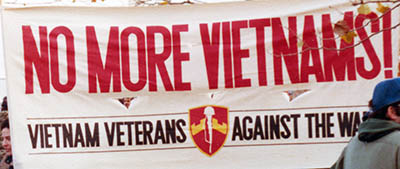 Download PDF of this full issue: v45n1.pdf (26.4 MB) Download PDF of this full issue: v45n1.pdf (26.4 MB) |
50th Anniversary Commemoration vs. the Truth
By John Ketwig
[Printer-Friendly Version]
Today there are 58,262 names on the Vietnam Memorial Wall in Washington, D.C. The government didn't used to keep records, but it is generally acknowledged that a far greater number, probably something over 150,000 Vietnam veterans have committed suicide since returning from the war. And while we debate government spending cuts to health care, Social Security, and education to ease the 18 trillion-dollar national debt, few Americans are aware that our government is beginning a $65 million campaign to alter America's image of the Vietnam War and paint it as an honorable, even noble experience.
The history of PTSD resulting from the Vietnam War is tragic. By the time the big numbers of Americans were deployed to Southeast Asia, the Pentagon, CIA, General Westmoreland, and MACV had developed a modern-day concept of a war of attrition that incorporated tactics, strategies and weapons so horribly effective, so cruel, and so deadly that the warfare we witnessed turned our stomachs. Clearly, the Pentagon will not direct its patriotic spotlights toward the veterans suffering from PTSD forty and fifty years after returning from Southeast Asia, or the thousands who have taken their own lives. "Those who cannot learn from history are doomed to repeat it," George Santayana wrote, and as the Pentagon celebrates the war in Vietnam and simultaneously drags out the current conflicts in the Middle East indefinitely, we must strive to learn from the past and be realistic as we plan for the future.
Since World War II, America's laboratories, think tanks and war colleges have developed the science of brutality, killing, destruction, and terror to levels of sophistication and brute force that are unprecedented in the history of the world. General Westmoreland spoke of the war in Vietnam as an "opportunity to test our latest weapons and tactics," and in that respect, and only in that respect the war was an overwhelming success. Three million Vietnamese, Cambodian, and Laotian peasants died, along with approximately 58,262 Americans, and hundreds of allied troops from Australia, Korea, and Thailand. The efficiency of our state-of-the-art weaponry was proven beyond question, along with the terrible toll wrought by the strategy of "search and destroy." We dropped more tons of explosives on Vietnam than were used in all of World War II, against both the Nazis and the Japanese. The damage to a poor agricultural country approximately the size of Connecticut cannot be imagined unless you were there to see it for yourself. Similar destruction of Laos and large areas of Cambodia provided the American military-industrial complex with enormous quantities of "test" results even as it devastated the powerless peoples of those lands.
Today it is estimated that more than 150,000 of America's veterans have committed suicide since returning from Vietnam. The Department of Veterans Affairs does not keep reliable statistics about veteran suicides, and the Pentagon claims it has not kept records. As a result, while we recognize that suicide has become far more prevalent among veterans since the Vietnam War, the statistics that would clearly define the scope of the problem simply don't exist. It seems obvious that hard numbers will probably never become available, especially from the government or military, because of the negative impact they might have on the military's recruiting efforts.
We have become aware of the military suicide problem through a torrent of media attention. Newspaper and magazine articles and TV news have all recognized the disastrous statistics, the President recently signed a "Suicide Prevention for American Veterans Act" into law, but the real question is whether we are actually addressing the causes of the epidemic, or simply putting a band-aid on a hemorrhage?
The military has long sought to portray the veterans afflicted by PTSD as somehow predisposed, weak or susceptible. There has been no scientific verification of these suggestions, but they are widely accepted among Pentagon spokesmen. The simple fact remains that a great many American soldiers are very understandably troubled by what they saw in Vietnam, or what they are seeing in today's war zones, and the emotional and moral dilemmas they feel are the mental roots that flower as PTSD. Post-Traumatic Stress Damage is, at the bottom line, just a word-managed term for conscience. Try as they might, the Pentagon planners cannot hide the fact that we are testing weapons on people, and our military incursions have not really been good for the people of Vietnam, Iraq, or Afghanistan. In fact, they have done tremendous harm to our veterans who have witnessed the carnage.
John Ketwig is a life member of VVAW, and the author of "...and a hard rain fell: A G.I.'s True Story of the War in Vietnam" which will mark its 30th anniversary in print this May. John is currently working on a new book which is intended to challenge the government's 50th anniversary commemoration.
|



